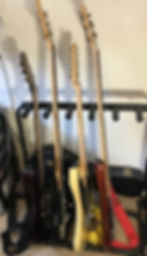Practice 101: Part 1
- Eric Dylke
- Apr 16, 2020
- 3 min read
Let’s face it.
Practicing is hard!
It’s time consuming. It’s frustrating. It can feel like a chore.
However, if you are able to endure those challenges, the gain far exceeds the pain.
Confidence, patience, discipline and focus are all fruits of consistent practice.
Over the next few weeks, I want to give you, students and parents, my tried and true tips to make practice the most effective it can be.
Let’s get started.
First things first. Before practice even starts, you need to consider your PRACTICE SPACE. Do you have one? Where is it? What’s in it? The answers to these questions will impact your ability to practice well. In my view, there are 4 essential components to an effective practice space:
The Spot
The Chair
The Stand
The Instrument
THE SPOT
In my office, I have an audio workstation. It is absolutely amazing for recording, mixing, and editing audio. Perfect for transcribing songs and making worksheets for my students. I can even kick my feet up and relax for a coffee break.

It is the worst for practicing.
Why? It’s full of distractions. The Internet, email notifications, bright shiny buttons…you get the idea.
Another important consideration for your practice space is the association you have with it. When I sit at the dinner table, I know it’s time to eat. When I lay on the couch, I know it’s time to watch a movie. When I sit in my practice chair, I know it’s time to practice.
So, ultimately you want a space that is distraction-free and exclusively used for practice. In an ideal world, this would be a designated room. But, if you don’t have the extra room to spare, don’t despair (see what I did there!?).
Remember my sweet audio workstation setup? Well, I take the folding chair I use for my students and I turn it to face the corner. I plop my music stand in front of me. I’m good to go.

THE CHAIR
Seems kind of obvious, but you need a chair.
At my workstation I sit in a nice, cushy, comfy office chair. It raises and lowers with ease, it’s got arms that move up and down. And it spins! The fun that I have on this chair is endless.
Again, great for office work, terrible for practice.
Your practice chair should allow for both comfort and technical success. It should be armless, fixed in position, and comfortable to sit in for longer stretches of time. Also, it is important that your student’s feet can touch the floor. If this is not possible, either change the chair or add a footstool.
So, now you know where you’re practicing, you have a chair to sit in…hmm, where to put your music?
THE STAND
This one is easy. You should have a music stand. Position is important.
Place the stand close enough to see and reach any music you put on it, but not so close that you bang your instrument on it. To avoid poor posture and neck strain, make sure the stand is at eye level directly in front of you.
If you don’t have a music stand, don’t despair. Creative solutions abound: tape your music to the wall, use a magnet and whiteboard, prop it upright against a binder, etc.
THE INSTRUMENT
Finally! It’s time to pick up your instrument and start…but wait, where is it?
The answer to this question can make or break your practice routine. There’s an old saying, “out of sight, out of mind.”
If you can’t see your instrument, chances are you will forget about it. Equally, if it’s out of reach or a challenge to access you’ll be less motivated to pick it up and practice.
For example, I have a guitar rack in my office. There are multiple guitars in arm’s reach at all times. It’s great! I can play a scale or two while I’m waiting for a file to download from the web, or while I’m waiting for a student to arrive.

By contrast, I have acoustic guitars in my closet…in their cases…behind two sliding doors. Do you think I play them as often? Or, ever?
The best thing to do is set up a visible “home” for your instrument in your practice space. A guitar stand is a great option. If you don’t have a guitar stand, you can carefully prop it up against a corner so it doesn’t get bumped or knocked down.
Let’s recap:
1) Your practice spot should be distraction-free and devoted to practice.
2) You need a functional, comfortable chair that promotes good posture and technique.
3) You need a stand or equivalent tool at eye-level for your music.
4) Your instrument should be out and ready to play at all times.
Like anything worth doing, start small. Don’t be afraid to experiment. You’ll figure out the right combination as you go. The important thing is to START.
Next week, we’ll talk about important tools to have to get the most of your practice…
